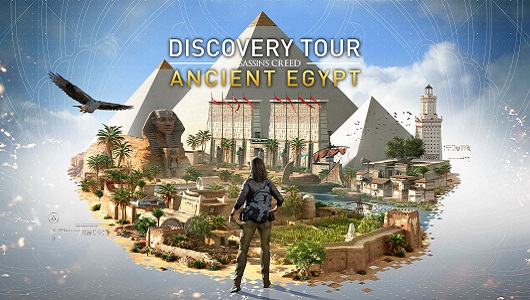With an Easter long weekend upon us, now is one of the best times to catch up on unplayed titles, new expansions and any DLC that might have been missed. One of those is Ubisoft’s final chapter in their refreshed Assassin’s Creed franchise and at almost ½ the size of the original full game The Curse of the Pharaohs is one of the best.
• Developer: Ubisoft Montreal
• Publisher: Ubisoft
• Reviewed on: Xbox One
• Also Available On: PC, PlayStation 4
• Release Date: Available Now

Looking back at Assassin’s Creed Origins, not since probably The Witcher 3 have I been so impressed and engrossed in a game, which is high praise for Ubisoft who have finally found their groove balancing ‘games as a service’ with a large open world, some RPG elements and a rich historical backdrop of Ancient Egypt, Greece and Rome.
Even since February when The Hidden Ones was released there have been constant patches, a slew of new content and free game modes, updates and scaling to weekly and seasonal events and then The Curse of the Pharaohs takes this and adds 14GB of new content including Thebes as the capital city of ancient Egypt, The infamous Valley of the Kings, and finally, finally Bayek of Siwah gets to go to the underworld in some of the most creative Assassin’s levels yet.
The story and meta-narrative around Assassin’s Creed has always been convoluted and The Curse of The Pharaohs probably adds to this more so, jumping forward in time to the same period as The Hidden Ones but, where that story was “historically accurate” and fed into the broader mythos of establishing the first Assassin’s Creed Order, The Curse of the Pharaohs takes a more fantastical approach that is thematically sound to many of the beliefs, myths and legends that surround fictional Egypt come to life. This says nothing of the fact that this is all still technically happening inside the mind of a young woman in the real world who is trying to discover the origins of a proto human-alien race that seeded life on Earth.

Bayek of Siwah embarks on the longest fetch quest in human history to recover the Aten – basically a sun orb in the name of the God Ra (or the alien “apple of Eden” orb from previous games for those playing at home) – to stop a curse that is sweeping Thebes and restore order to the underworld. Outside of the main map he must descend into 4 different regions of the afterlife including the much touted and talked about field of reeds, to defeat and put to rest four of Egypt’s most famous and notorious Pharaohs including Tutankhamen, Nefertiti, Akhenaten and Ramesses.
Entry to the underworld is through the different Pharaohs tombs, which leads to one of the biggest flaws in Ubisoft content albeit one that is less annoying but that could have been addressed another way: Maps, within maps, within maps. Ignoring that you can still exit Egypt for the real world, both Origins expansions have been shoehorned into the game’s map through an ‘Atlas’ which you need to open to bring up the different DLC and regions. Now within that map using yet another control on the new tomb icons, you can go deeper down the rabbit hole and load the maps for the afterlife regions that are self-contained and rather large sections of similar gameplay to the rest of the game.
Meanwhile, Thebes, The Valley of the Kings and the surrounding desert regions are already quite expansive, compared to the small peninsula in The Hidden Ones, but adding a further 4 regions on top of that means even more gameplay and content and this is where the game shines.
The portals into Aarru, Aten, Duat and Heb Sed are worth the price of admission and for higher level players, still manage to do a few things different challenging both the hand to hand combat developed for the game as well as providing a number of tombs, and fantastical creatures sorely missing from the main Origins title.
- New giant scorpion animals, side quests and locations to discover and unlock
- Mummies that can be burnt for achievements
- For a large part Romans are replaced with Anubis Guards: Jackel Headed guardians of the dead
- A new undead Mount to traverse the field of reeds
- Because of the curse throughout the day & night larger than normal level 55 ‘Pharaoh’s Shadows’ will spawn in random locations outside the underworld and start attacking and massacring the locals and Romans alike
- The Phalanx that used to stalk you are now replaced with lvl 45-55 undead Tomb Guards to hunt

Hand to hand boss battles were fundamentally missing from Origins relegated to the Arena or specific story points. In part, this was to make room for the seasonal Challenge of the Gods content that has seen players compete to defeat massive incarnations of fictional Egyptian Gods on a weekly rotating basis. These events though are wave based and have become shallow following a rinse and repeat the formula of shooting arrows at a large target’s chest.
Curse of the Pharaohs sees Bayek singularly squaring off against actual Kings and Queens (albeit dead ones) in hand to hand combat, alone and with limited space to move. Beat them and be rewarded with their selective golden weapons.
This is also proper post-game content and not just some second-hand DLC as the game now raises Bayek a further 10 levels from 45-55. Difficulty is increased with the addition of randomly spawning and roaming Pharaoh’s Shadows that plague Egypt outside of the underworld and can’t easily be beaten. It is much easier to just let them rampage, killing a selection of locals before returning back from whence they came.
With this in mind, Ubisoft seems to have finally figured out how to make the game harder for players and slightly more balanced without having to change an option in the menus. Balancing is still off though, in that the threat of these spawned enemies can be wholly avoided or simply ignored and they have little to no bearing on the player unless you choose to engage them.
Scorpions on the other hand, as the only animals that can poison, are a unique challenge regardless of level. Boss battles against the Pharaohs are genuinely hard and require skill to counter whatever move set or weapon the Pharaoh has. Not dissimilar to the boss battles in the Gladiator Arenas, but more dynamic and better integrated into the story with an immediate reward.
All said and done though, six months on from launch there is still only so many weapons one player can carry, so many different cosmetic outfits and mounts before it starts to become too much.
Ubisoft clearly has an issue providing pay for play content without encroaching on player sensitivity and unless you change mounts every other mission there is little incentive to collect them all. Weapons are at least practical but are upgraded with new ones, with better stats so often it becomes a game unto itself, logging in just to get this week’s limited edition community challenged golden item.

For players that have stuck with it, The Curse of the Pharaoh is a visual ‘coup de gras,’ rewarding those not with an engaging story but a metric ton of new content and 4 highly original underworld areas.
It is simply beautiful and a testament to their refined engine that the field of reeds has a literal never-ending view of rolling and undulating yellow grass as far as the eye can see. Boats ferrying the dead clip through the landscape in which there is no water, crossing back and forth between temples and statues. Other regions are only water and in the afterlife it is always daytime with a giant, impossibly large and fake sun orb sitting above the map, lighting the way. The water level is full of totally sunken underwater temples, lost treasures and ruins to explore; if you can breathe that long.
Discovery Mode
Discovery mode is a separate and complete mode of play unto itself and sadly, one that may not reach its full potential.
Basically, a walking tour of Egypt with audiobook-style narration, the sheer wealth of transposed content and audio logs is immense. Whilst Origins map may not be historically accurate, the idea to inform or use the game as a teaching tool for schools is an intriguing one as on the one hand it is not overly difficult to simply dump and Encyclopedias worth of narrated audio into the game.
Separate to this it is also the only part of Origins where players can finally play as someone else, including all the characters from the game such as Julius Caesar and a Byaks wife. There is literally a dozen hours of content here, if so inclined and presents the temples and statues and locations is new light as you navigate a pathway through history over 75 tours.
Patch 1.3.0 & 1.4.0
It should be noted that Discovery Mode is a completely free update of 5.5 GB of content that came with patch 1.3. If that isn’t enough still, then New Game+ mode as well is yet another reasons to go back in and do the story over. On top of this, the patches all come with new rewards and surprises for completing the 75 tours of Egypt as well as:
- New Horde Modes in the arenas
- Updated icons and color-coded UI menus on the world map
- Scaled Challenge of the Gods to reflect new higher levels of 45-55
- Community Challenges to win different coloured Anubis armour sets

Assassin’s Creed Origins is the game that keeps on giving. If The Hidden Ones was the origins of the Assassin’s Order and their inception then surely Curse of the Pharaohs is the catalyst for the origins of the Templars and one of the best look at the human forerunner race thus far. Whilst continuing content will be overlooked in favour of Far Cry 5 in the near future, Origins is one game that I am always happy to return to and if this is the final word in Bayek’s adventures, it is a fitting end to one of the best games in recent memory.
Big Red Barrel Review: Assassin’s Creed Origins
Big Red Barrel Review: Assassin’s Creed Origins: The Hidden Ones






